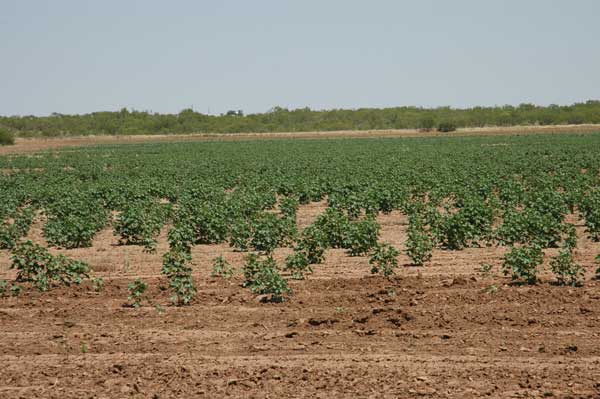
Failed cotton due to drought presents management concerns for follow-up crops
Drought made it hard to grow cotton this year and is also making it hard to kill the cotton in preparation for wheat or other follow-up crops.There is no ‘one recommendation fits all’ for killing cotton stalks.Tillage and herbicide applications may be effective.
October 31, 2011

Drought made it hard to grow cotton this year, but it is also making it hard to kill the cotton in preparation for wheat or other follow-up crops, according to a Texas AgriLife Extension Service specialist.
Dr. Gaylon Morgan, AgriLife Extension state cotton specialist, said many producers in the Blacklands and Rolling Plains are looking at planting or have planted wheat into harvested or destroyed cotton fields, which could present some problems.
“As the cotton stalk-destruction deadline quickly approaches in East and Central Texas, numerous farmers have indicated cotton stalks are more difficult to control with both tillage and chemicals this season,” Morgan said.
“Cotton is a perennial plant that we grow as an annual crop,” he said. “This is never more obvious than when we are trying to kill the cotton plants and prevent host plants for the boll weevil.”
Morgan said factors contributing to increased difficulty with control of cotton stalks this year include:
Early harvested fields have more time to regrow following tillage or herbicide applications and prior to the first killing freeze.
Under moisture-stressed conditions, herbicide efficacy is reduced.
Residual nutrients that were not used by the cotton plant early in the season can encourage regrowth.
“Unfortunately, there is no ‘one recommendation fits all’ for killing cotton stalks, especially in a dry year with prolonged growing conditions following harvest,” he said. “However, there are some general management strategies that should be considered and have proven effective in the past.”
On the tillage front, pulling stalks has typically been quite effective, followed by other tillage methods, Morgan said. However, it is common to have a sufficient number of stalks still standing that require another tillage operation or herbicide application to meet the Texas Department of Agriculture stalk-destruction requirements.
Herbicide options
On the herbicide front, more than 10 years of applied research and demonstration trials have been initiated to evaluate the efficacy of chemical-stalk destruction, he said.
Previous research in Texas has indicated the most effective and consistent herbicide is 2, 4-D at 1 to 1.5 pounds of active ingredient per acre on standing, freshly shredded (one to four hours after shredding) or delayed applications (two to three weeks after shredding).
The herbicide Clarity, at 0.5 pound of active ingredient per acre, has been the best alternative to 2, 4-D, but has typically provided slightly less kill than 2, 4-D, he said.
Although 2, 4-D and Clarity typically provide more than 90 percent kill, where growing conditions remain favorable for approximately 60 days or more after herbicide application, a follow-up treatment may be required to kill any remaining host plants, Morgan said. If a second herbicide application is required, 2, 4-D at 0.5 to 1 pound of active ingredient per acre or Clarity at 0.5 pound of active ingredient per acre is recommended.
In years with early harvest and a warm fall, growers may see some advantage to the delayed herbicide applications, two to three weeks after shredding, he said.
“The herbicide efficacy is comparable, but this delayed application may decrease the chance of a second application being necessary and can also help control emerging seedling cotton,” Morgan said. “However, herbicide efficacy can be hindered as temperatures cool in the fall.”
Problems also may occur in cotton fields that are planted into wheat, he said. This cropping sequence has numerous benefits, but one challenge in South, Central and East Texas is destroying the cotton crop prior to planting wheat or after wheat establishment.
When destroying cotton stalks prior to planting wheat, remember 2, 4-D has a minimum of a 30-day planting restriction for wheat, Morgan said. Even observing this 30-day planting restriction, some wheat injury can occur, if inadequate rainfall occurs. At the recommended rate of Clarity for cotton stalk destruction, the plant-back restriction is 44 days.
When destroying cotton stalks in established wheat fields, 2, 4-D is labeled for application to fully tillered wheat through the boot stage, he said.
Applications of 2, 4-D prior to the full-tiller stage can significantly decrease yields. Clarity is labeled for application from wheat emergence through jointing; however, the labeled rate is a maximum of 4 ounces per acre.
Morgan said several other products are labeled for post-emergence broadleaf weed control in wheat, include Affinity Broadspec, Aim, Buctril, CleanWave, ET, Huskie, Peak and Starane, and this should provide sufficient suppression of cotton stalks until the first killing freeze occurs on cotton.
He referenced several publications to provide more information, including “Managing Volunteer Cotton in Grain Crops,” “Weed Control Recommendations in Wheat” and “Cotton Stalk Destruction with Herbicides.”
You May Also Like



